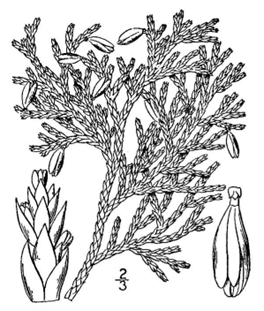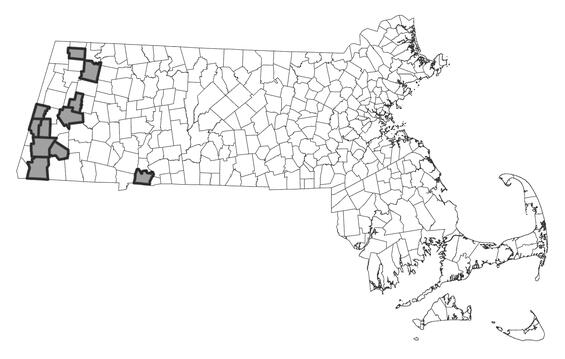- Scientific name: Thuja occidentalis
- Species of Greatest Conservation Need (MA State Wildlife Action Plan)
- Endangered (MA Endangered Species Act)
Description

USDA-NRCS PLANTS Database / Britton, N.L., and A. Brown. 1913. An illustrated flora of the Northern United States, Canada and the British Possessions. 3 vols. Charles Scribner's Sons, New York. Vol. 1: 65.
Arborvitae or northern white-cedar is a medium-sized, somewhat cone-shaped tree in the cypress family (Cupressaceae). It grows from 15-18 m (49-59 ft) in height. Its short trunk is 30-92 cm (12-36 in; 1-3 ft) in diameter and is frequently buttressed. Arborvitae’s bark is thin, narrowly ridged and fibrous, and ranges from gray to red brown in color. The twigs are flattened in appearance and branch profusely in one plane; terminal branchlets are from 1-2 mm wide (0.04-0.08 in) and form fan-shaped sprays. The 1.5-3 mm long leaves (0.06-0.12 in) are a bright yellow-green and form four rows of overlapping scales that are tightly appressed to the branches. Only the tips of the scales are free. These leaves give off a spicy fragrance when crushed.
Arborvitae is a monoecious tree: it has unisexual flowers, and each plant has both male and female flowers. The pinkish female flowers arise from the tips of the terminal branchlets while the yellowish male flowers appear near the bases of branchlets. Arborvitae’s pale-brown, egg-shaped cones are 7-13 mm long (0.28-0.51 in) and are composed of pointless, overlapping scales. Cones appear in April or May, and female cones ripen during their first autumn.
The wood of arborvitae is soft, light, and extremely resistant to both decay and termite damage. As a result, it is frequently used for poles, fences, and railroad cross-ties. It is also a popular ornamental tree. The trees supply shelter for white-tailed deer, and their leaves and bark provide forage for deer, rabbits, porcupines, and squirrels.
Atlantic white cedar (Chamaecyparis thyoides) could easily be confused with arborvitae. However, the scale-like leaves of Atlantic white cedar are a dark blue-green. Furthermore, the cones do not have overlapping scales but, rather, have peltate scales. (Peltate scales are attached to a supporting stalk that connects inside the margin, somewhat like the stalk of a mushroom). Finally, the terminal branchlets of Atlantic white cedar are somewhat thinner than those of arborvitae – only 1 mm in width.
Population status
Arborvitae is listed under the Massachusetts Endangered Species Act as endangered. Massachusetts Natural Heritage & Endangered Species Program database has 15 records from 2 counties: Berkshire and Hampden. Ten of those records are within the last 25-year period. All listed species are protected from killing, collecting, possessing, or sale, and from activities that would destroy habitat and thus directly or indirectly cause mortality or disrupt critical behaviors. Causes of its rarity in the state include the scarcity of its habitat and the fact that Massachusetts is at the southern edge of its range.
Distribution and abundance
The documented range of arborvitae extends from Nova Scotia and Quebec to Hudson Bay, through central Ontario and southeastern Manitoba, and south to Maine and Minnesota. Disjunct populations occur in Ontario, Manitoba, southern New England, Illinois, Ohio, and in the Appalachians from Pennsylvania to Tennessee.

Habitat
Arborvitae prefers moist sites, especially near streams or on calcareous soils. In Massachusetts, habitats include an alkaline seepage fen (an area where cold, alkaline, nutrient-poor groundwater seeps to the surface), dolomitic ledges along a railroad cut, the lower slope of a steep riverside bank with a natural seep, and an open, calcareous depression bisected by a stream. Species associated with arborvitae include shrubby cinquefoil (Dasiphora floribunda), porcupine sedge (Carex hystericina), a species of rush (Juncus dudleyi), tamarack (Larix laricina), and grass-of-parnassus (Parnassia glauca). Rare Massachusetts plants that have been found with arborvitae include great blue lobelia (Lobelia siphilitica, endangered), labrador bedstraw (Galium labradoricum, Threatened), autumn willow (Salix serissima, non-regulatory plant watch list), and hoary willow (Salix candida, non-regulatory plant watch list).
Healthy habitats are vital for supporting native wildlife and plants. Explore habitats and learn about conservation and restoration in Massachusetts.
Threats
Threats to arborvitae include flooding caused by beaver dams and by roads that cross wetlands.
Conservation
All active management of rare plant populations (including invasive species removal) is subject to review under the Massachusetts Endangered Species Act and should be planned in close consultation with the MassWildlife’s Natural Heritage & Endangered Species Program.
Contact
| Date published: | May 7, 2025 |
|---|